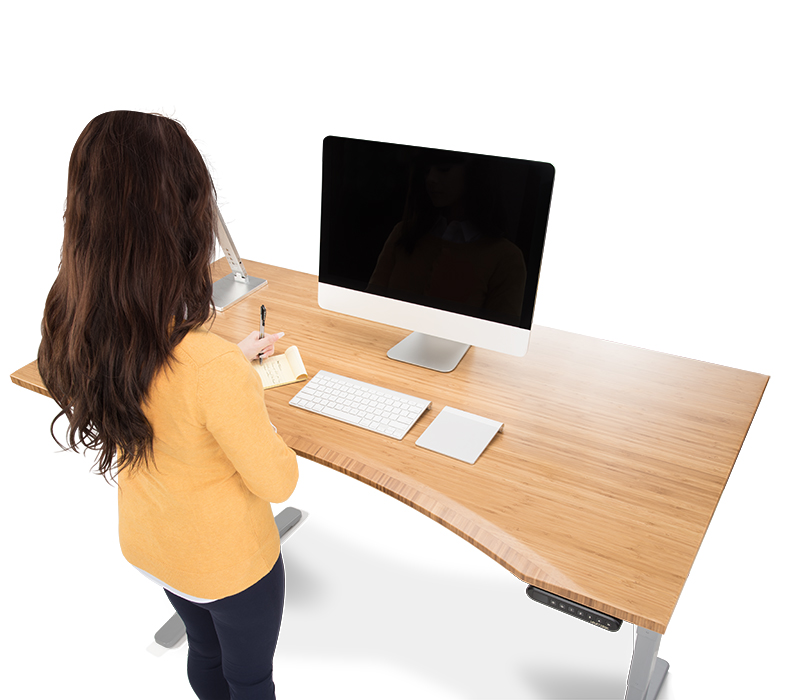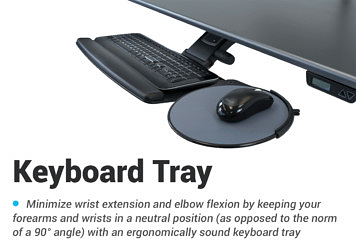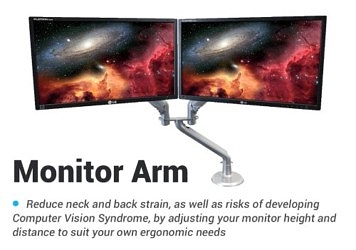UpliftDesk Tabletops For Standing Desks
Like most reviews sites, our editorial staff and laboratory testing expenses are partially offset by earning small commissions (at no cost to you) when you purchase something through those links. Learn More

Overview
| Review Summary |
Uplift is one of the few desk manufacturers that have a decent number of options when it comes to size, color, or materials to get a desk that matches your workspace. However, when we see multiple independent customer reviews showcasing how they can delaminate, crack, chip, scratch, warp, or discolor, it is hard to recommend most of them over any other commodity-grade tabletop supplier. “15 year” warranty has extensive carve-outs that mean anything other than shipping damage on the way to the customer is likely not going to be fully replaced or refunded. Too many greenwashing marketing claims, especially on bamboo, rubberwood and “Eco” powder coat tops. Unless you’re replacing one of their failed tops on your Uplift desk, there are better places to go for finding a high quality top for DIY standing desk projects. |
|---|---|
| MSRP / List Price | $299 |
| Street Price |
24″ and 30″ depths are same price |
| Shipping |
Shipping is free in the contiguous 48 United States |
| Warranty |
15 years, ostensibly (5 years on solid wood). However, damage that other manufacturers would cover under warranty are often considered “normal wear and tear” by Uplift, often only offering a discounted replacement after the first 30 days, according to customer reports. |
| Sizes Available |
Greenguard Laminate and Bamboo: |
| Colors Available |
Greenguard Laminate: White, whiteboard, black, ash gray, walnut, maple, cherry |
| Competition |
Compare to Other Desktop and Tabletop Surfaces
|
| Where to buy |
Buy on Amazon |
Rating
| Reliability | |
|---|---|
| Customer Experience | |
| Quality and Aesthetics | |
| Ergonomics | |
| Innovation | |
| Value | |
| Positives | Many size, color, and material combinations for shoppers to choose from. Long 15-year "warranty". Curved and beveled option on some models that endeavors to be provide "ergonomic" tabletop use. One of the few desk top manufacturers that properly packages them for enduring the brutality of parcel carrier networks, so relative to others Uplift's shipments tend to have a lower damage rate en route to the customer. |
| Negatives | Low quality materials that are easily damaged by light use. Warranty not upheld when they claim obvious defects as regular "wear and tear". Greenwashing of bamboo and rubberwood materials when they have more negative environmental impact than other domestic options. |
Bottom Line
While most people buy their standing desk as a complete system, i.e. getting the lifting base and the desktop together from the same seller, you may find yourself needing to acquire a new desktop on its own. For example, you may already own a standing desk but the top has gotten damaged, or you may want to upgrade to a different size and/or color. Whatever the reason, there are a mountain of options to choose from. Read our Guide to Buying The Best Tabletop For Your Standing Desk to ensure you know what to watch for when purchasing a standalone top for your desk or table.

In this review we explore the desktops individually sold by Uplift, and discuss where they may excel and where they might fall short of consumer expectations.
A Cornucopia of Standalone Tabletop Options For Standing Desks
The first thing our experts noticed about Uplift’s desk tops (at least on the positive side) was the number of choices shoppers have to match their desired style. There aren’t many other tabletop manufacturers out there that provide this number of combinations in size, color, and even material. Not all of those choices are necessarily good (more on that below), but the choices are plentiful.

Most of their tabletop models come in 9 different sizes (not so with their custom solid wood tops), which is more than some who offer only a “large” or “small” desk top size. They have 7 different laminates, including woodgrain colors and even a whiteboard option. Uplift offers three shades of bamboo, two of rubberwood, and 14 different styles of solid wood that are usually in stock. So, whatever decor you have, Uplift is likely to have something that will go with it. The only desk top manufacturer that offers more combinations (many times more) of sizes, shapes and colors is iMovR.
<id=”warranty-gamification”>
Warranty Gamification
Another thing you won’t see often on most tabletops sold online is a “15-year warranty” like Uplift’s. The Boeing 747-sized caveat for that warranty praise is what Uplift considers “normal wear and tear” for their surfaces, especially the bamboo and solid wood. We will dive more into the quality deficiencies later, but apart from that, 15 years is a long time to cover an Asian-import product like this that isn’t of the highest quality. To some degree this is a numbers game for Uplift… balancing increased sales stimulated by promoting the longer warranty against a higher potential cost of replacing defective tops on their Uplift V2 standing desks.
Uplift has incrementally increased their coverage term in lockstep with head-to-head competitor Fully over the years. Both of which were trying to keep up with iMovR’s industry-leading “made-in-USA warranty,” which is a true 15-year warranty on a product that actually has commensurate durability. So it’s a strategy of employing extensive carve-outs to the point that it would be exceedingly hard for a user to ever get a full replacement under warranty except for shipping damage.

Another tactic they use to reduce their warranty exposure is borrowed from the contract furniture industry, called “multi-shift use.” If the desk is used for more than “one shift a day” then the warranty term is reduced proportionally for usage greater than 40 hours per week. For those who work from home answering this question honestly might result in a drastically reduced coverage period.
From what we can see in numerous references on Reddit, unless the product is damaged in shipping, Uplift’s customer service response to any manufacturing defect is to call it a “normal wear and tear” or “user abuse” issue, and offer a discount for the customer to buy anew one of these standalone tops to replace the failed unit.
Failure to honor their warranties is unfortunately one of the most common complaints we hear from users about the Uplift brand, which of course you won’t read about in the curated reviews on their own website. This is one reason we always recommend buying Uplift products on Amazon, to gain a much higher degree of consumer protection, even if it costs a little more. Even if the returns window is the same 30 days, Amazon sellers live in perpetual fear of bad reviews that’ll de-rank their product listings, so they tend to treat warranty concerns from Amazon customers much more liberally. Be sure to read more about comparing standing desk warranties so you know what to look for when deciding on your standing desk or standalone tabletop purchase.
Some Uplift Tops May Be More “Ergonomic” Than Others
One possible bonus to Uplifts desk is at least an effort to make their tops more ergonomic. Some of their models come with a curve in the front for users to sit closer to their screens if they need to, or to have their mouse in a more comfortable position to use. Those also have an angled edge that can be more comfortable for an arm or wrist to rest than their harder edges. In the Uplift line-up this curve option seems to be limited to just their bamboo and “Eco” powder coated tops.
 An “ergonomic curve and beveled edge can provide a limited amount of more comfortable use for some users.
An “ergonomic curve and beveled edge can provide a limited amount of more comfortable use for some users.We’re big fans of ergo-contouring the edges of a desk top in general, but concave curves along the user edge don’t really fall into the same category. While a mild ergonomic argument can be made for them, these curves are really more of a stylistic choice that looks more interesting than a regular rectangle.
Buyers should also be aware that a curve along the user edge might be incompatible with some accessories you use on your desk, like large rectangular mouse pads that gamers often use, or keyboard trays that install best on desks with a straight user edge. We also came across a surprising number of users on Reddit who regretted buying a curved desktop, and some who had complaints about it but said they’d buy it again because they liked the look. So this is a very subjective matter.
Fancy Marketing for Lower Quality Desk Tops
If you just look on the surface of Uplift’s website and marketing materials, it is easy to get pulled into their fancy claims and well-lit photography. The many truly independent customer reviews we found online tell quite a different story.
They tout their bamboo desktops as being super durable and good for the environment, but that is a form of greenwashing that just glosses over all the harm that bamboo products from China do to the environment. Read more about the harms of bamboo in our article that separates fact from fiction on bamboo marketing claims.
One review of their bamboo top said that their top began to discolor after a very short time but only where their arm rested to use a mouse, which they couldn’t fix and Uplift wouldn’t replace because they called it “normal wear and tear” even though that seems like a deficiency in the varnishing process. If that is normal enough to consider “wear and tear” that is a very cheap and low-quality finish.
A similar situation happened to a customer where their desk started to split after only 3 months. But instead of covering that under their warranty, they are only offering a new top at a discounted price. This seems to be a normal way that Uplift deals with avoiding warranty replacements due to the low quality of their tabletops.
Whereas the warranty term touted by a manufacturer should be a reliable indicator of how long a consumer should expect their purchase to last, we haven’t seen any table top offerings sold by the company that could remotely last 15 years — not in HPL, bamboo, rubberwood, powder coat or anything else. Other popular sellers offer only one or two year warranties on these same low-cost table top lamination technologies.

Similarly to their greenwashing of bamboo products, they do the same with their Eco model, which they tout as environmentally friendly because of the recycled material and lack of chemicals. It is just the same MDF that is the core of most other desks, which is always “recycled” in a sense. True, it doesn’t use any other chemicals in gluing laminates to it because it is powder-coated (basically, spray painted), which is one of the cheapest and least durable ways to finish a desktop surface. Some people have even reported the paint wearing away from accidentally spilling soda or just condensation from a cold drink placed innocently on the desk. The Eco is not a great option in most cases.
Uplift has joined with many other desk makers jumping on the rubberwood bandwagon recently, trumpeting it as the latest and greatest environmentally sensible material for a standing desk table top. One good side of rubberwood is that it has very little shrinkage, making it one of the more stable construction materials available for furniture. But it has many of the same issues as bamboo, like chipping or flaking. For more information on using this material as a desktop, read our article on separating the truth from fiction on rubberwood.
For Uplift’s solid wood desk tops, the price is a great teller of the quality. We’ll be adding reviews of their standalone solid wood tops in the near future, but for now you can get all the same information by reading our reviews of Uplift’s solid wood V2 standing desks in our roundup of the best solid wood desks we have seen.
So this leaves the laminated models, which don’t escape the quality critique. The type of lamination on Uplifts tabletops is just the standard HPL (high-pressure laminate) that most commodity-grade manufacturers use. HPL is infamous for separating from the core, the adhesive that holds the edge banding wearing away due to normal cleaning (especially with disinfectants), changes in humidity and temperature, and just time. It can also be pretty easily damaged by chair backs banging into it because of the hard corners. All this can result in the desk eventually warping from moisture penetration (especially around the unsealed grommet holes), and likely not covered by the warranty.
Uplift Tops Might Downgrade Your DIY Standing Desk
In the end, Uplift is one of the most popular standing desk brands, and there is a reason for that. They provide a variety of styles to choose from at a competitive price. This variety allows them to have something that fits almost every kind of office décor. They do take some effort to make some tops more ergonomic for users, and the 15-year warranty is theoretically nice to see.
However, when you look at the overall quality, the number of complaints, and the environmentally unfriendly greenwashing of their marketing, these desks don’t measure up to better models that are made in the U.S. that only cost a bit more but will last much longer. And their prices aren’t always lower, perhaps reflecting a high shipping damage or returns rate. For example when we reviewed their rubberwood desk tops we were surprised to see them selling for more than iMovR’s state-of-the-art 3D laminate tops of the same size.
Many standing desks come with grommets for some added convenience. Check out our article on grommet holes, with everything you need to know about the different ways to use them to enhance your workstation, what to look for in your grommet holes, and where to find the desks with the best ones.
Don’t forget to learn all you need to know about finding the perfect desktop for your standing desk workstation in our primer – DIY Standing Desk: Choosing the Right Desk Top.
If you don’t already have a base and frame, make sure you know how to choose one of those as well by reading our guide to buying standing desk bases. Or skip the DIY project altogether and go for one of the better complete standing desk systems available today.





0 Comments
Leave a response >